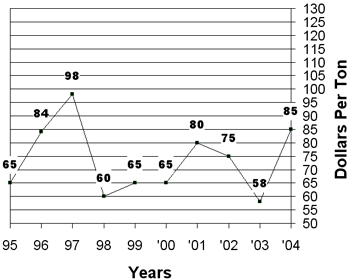Production Update:
National Alfalfa Symposium: The National Alfalfa Symposium
will be held in San Diego December 13-15, 2004. This symposium is a more
national version of the annual California Alfalfa Symposium with several
topics of broad interest, but many of the topics are regional in nature.
Information for this symposium can be found at http://alfalfa.ucdavis.edu/subpages/2004Symposium/2004SymposiumHome.html
Insect Management: Alfalfa is a major acreage crop in
the low desert and a major reservoir of beneficial insects. Alfalfa in
bloom provides pollen and nectar for honey bees and other species of bees.
Alfalfa also is a home for many predaceous bugs (
pictures) such as assassin bugs, bigeyed bugs, damsel bugs, and minute
pirate bugs. These predaceous insects along with several species of spiders
feed on many pest insects in alfalfa such as beet armyworm and alfalfa
caterpillar. In addition, several parasitic insects are at home in alfalfa,
such as Hyposoter exiguae (
picture),
a wasp parasite of beet armyworm, and Cotesia medicaginis (
picture),
a parasite of alfalfa caterpillar. Therefore, alfalfa should never be
treated with an insecticide that will kill beneficial insects unless the
crop is threatened with sever loss by pest insects. Destroying these beneficial
insects often leads to severe outbreaks of other insect pests
Weed Control: All of the preplant herbicides registered
for use in alfalfa can cause crop injury. These include Eptam and Balan.
Trifluralin (Treflan) will reduce the new stand by 40 to 60% if put on
prior to crop emergence. Prowl is not registered on alfalfa and will also
hurt new seedlings if it is not incorporated.
| Market Summary |
High
|
Low
|
Average
|
Off grade
|
| Past 2 Weeks ( 2004) |
90
|
80
|
85
|
70-80
|
| Last Year ( 2003) |
60
|
50
|
58
|
40-50
|
10 Year Summary (August 10, to August 23, 1995-2004):

Issued in furtherance of Cooperative Extension work, acts of May 8 and June 30, 1914, in cooperation with the U.S. Department of Agriculture, James A. Christenson, Director Cooperative Extension, College of Agriculture and Life Sciences, The University of Arizona.
The University of Arizona is an equal opportunity, affirmative action institution. The University does not discriminate on the basis of race, color, religion, sex, national origin, age, disability, veteran status, or sexual orientation in its programs and activities.
Any products, services, or organizations that are
mentioned, shown, or indirectly implied in this web document do not imply
endorsement by The University of Arizona.
Information provided by:
Barry Tickes, btickes@ag.arizona.edu Extension Agent, Yuma County
Michael Ottman, mottman@ag.arizona.edu Agronomy Specialist
College of Agriculture, The University of Arizona.
Eric Natwick, etnatwick@ucdavis.edu UCCE Imperial County - Farm Advisor
University of California, Davis, CA.
Forages: Crop Mgmt | Soil Mgmt | Irrigation | Alfalfa Reports | Insects | Diseases | Weeds | Pesticides
Home | Other Crops | Forages
For more Arizona Production Ag Information:
Home | Cotton | Veggies| Forages | Grains | Citrus | Crop x Crop | Insects | Diseases| Weeds | Pesticides | News | Weather | Research | Photos | Contacts | General Info. | Site Map
Copyright © 2001 University of Arizona,
College of Agriculture and Life Sciences
Webmaster: Al Fournier (fournier@ag.arizona.edu)